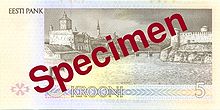



The 5 krooni banknote (5 EEK) is a denomination of the Estonian kroon, the former currency of Estonia. Paul Keres (1916–1975), who was a world-famous Estonian chess player, international Grandmaster and prominent chess theorist, is featured with an engraved portrait on the obverse.
The reverse features Hermann Castle founded in 1256 by the Danes and Ivangorod Fortress established by Ivan III in 1492. The 5 krooni banknote was only issued shortly after the reestablishment of the Estonian state in 1991, but remained in common use until the EEK was replaced by the euro. A 5 krooni coin was also minted but the banknote was more commonly found in circulation. The note can be exchanged indefinitely at the currency museum of Eesti Pank for €0.32.
Source:[1]
|
Estonian currency and coinage
| |
|---|---|
| Topics |
|
| Euro |
|
| Former Estonian Coins |
|
| Former Estonian banknotes |
|